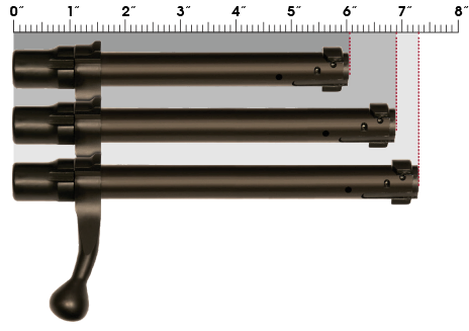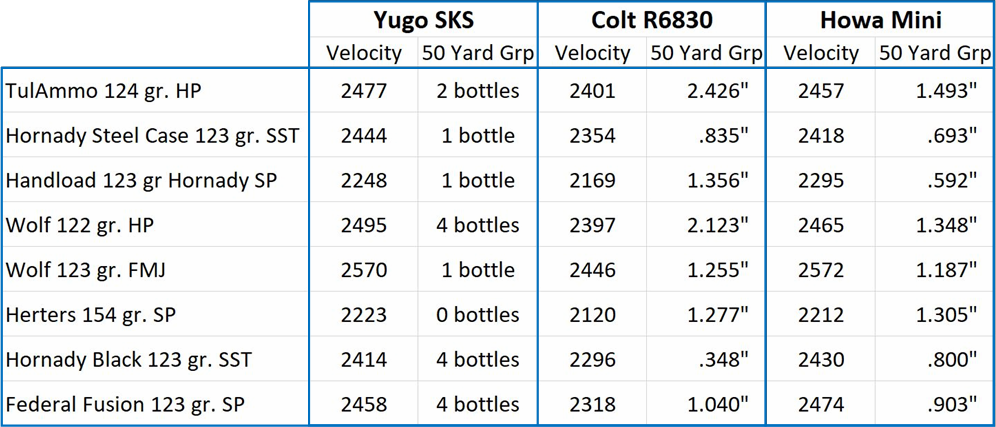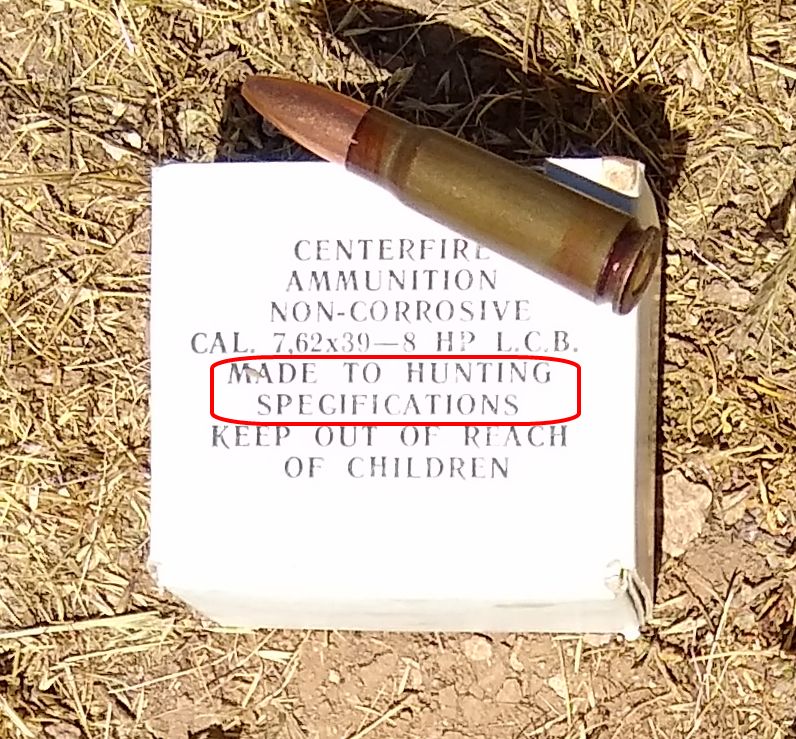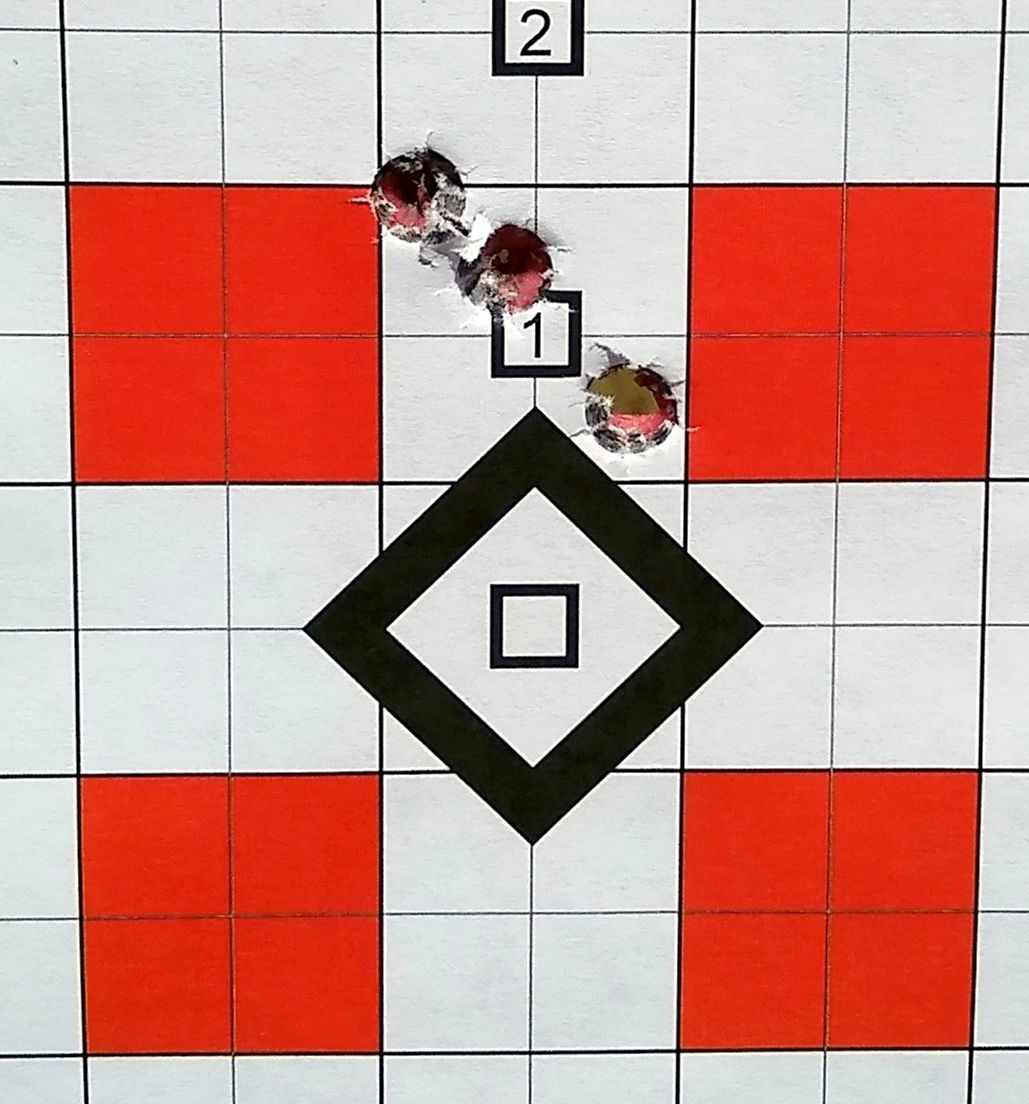The Russian M43 7.62x39mm cartridge has long been one of my favorites. In 1992
I acquired a Colt Sporter Lightweight, model R6830, in caliber 7.62x39. I’ve
often said to myself, and to anyone else who would listen, that this would be
the last gun that I would hold onto should I ever have to get rid of all the
others.
The reason? To me, it is the ultimate SHTF gun. Ammo is cheap, and it hits
hard (for such a small rifle cartridge). The 7.62x39 has a reputation for bad
accuracy, but in a quality rifle like the Colt Sporter, it is reasonably
accurate. It can be used quite effectively either for defense or for
subsistence hunting. Since that time, I’ve kept a small stash, a packed full
.50 caliber ammo can, filled with 7.62x39 ammo, in reserve, just in case. Now
that I think about it, maybe I should lay in a second full can.
Ten years later, in November of 2002, during the height of my military surplus
madness, I acquired my second rifle in 7.62x39. It is an excellent condition
Yugoslavian M59/66 SKS. In the days of the $69 Chinese SKS’s, and the cheap
Russians, I passed on getting one. So when these perfect condition Yugo SKS’s
became available at J&G for $150, I made it a point to get one. Today, it’ll
cost you $400 to $450 to add one of these to your collection.

|
To tell the truth, I don’t shoot this one much, but I still treasure owning it.
I just think that it is one of the coolest milsurps around. A unique feature is
that it has a gas cutoff switch to prevent the action from cycling. It has this
feature because the Yugos come standard with a NATO spec grenade launcher spigot
on the end of the barrel. When the gas cutoff switch is moved to prevent cycling
the action, you can raise a 4½” tall ladder sight that resides behind the regular
front sight. To launch a rifle grenade, you fit the grenade over the spigot,
cutoff the gas, raise the ladder sight, and load a blank round. That must be a
hell of a lot of fun to be able to unleash that kind of destruction with a little
old 7.62x39 SKS!
On top of all that fun, of course it also comes with the blade bayonet that unfolds
from the bottom. You didn’t think that rifles with cool gadgets attached was
something that was invented by the AR-15 market, did you?
In the late summer of 2018, I was browsing the Links page on our website, when
I decided to check in to see what was the latest with Howa.
I’ve had a soft spot for Howa rifles since I owned one for a time back in 1996.
I was wandering around a gun show and saw a new one for sale for the princely sum
of $299. It was in .30-06, and had a beautiful glass-filled synthetic stock that
was finished in such a way as to make it look like high-grade walnut. I already
had a .30-06, but the excuse I made for myself to buy it, was that I could set it
up as a loaner gun, should I be able to entice one of my brothers to come out to
Arizona to join me on a deer hunt.
As I recall, it shot pretty darn good. But after a couple of years went by, with
no sign that either brother would ever join me on a deer hunt, I decided that it
was surplus to my needs and I sold it off.
Let me explain a little about Howa. Howa is a Japanese rifle maker, but they make
very few finished rifles. At the time, the importer of my .30-06 was Interarms.
Today the importer is Legacy Sports International, out of Reno, Nevada.
The vast majority of what ships out of the Howa factory is barreled actions. Legacy
Sports imports the barreled actions, but sources the stocks and assembles the rifles
into finished goods, here in North America. Legacy then ships the finished rifles
around the world, wherever there is demand. Of course, Legacy has pull with Howa to
specify barrel lengths, barrel weight, calibers, etc.
Over the years, Howa has also supplied private label barreled actions to other gun
makers. In the past, both Smith & Wesson and Mossberg marketed Howa rifles under
their own brand names. Today, the Weatherby Vanguard is a privately-labeled Howa.
Weatherby has changed the shape of the bolt shroud a little, but in all other
respects, it is a Howa Model 1500 barreled action.
So what was it that caught my eye on the Howa website? It was something called the
Mini Action. It turns out that in 2017, Howa introduced a new shorter-than-short-action
version of their rifle. Action lengths now come in three sizes, Long Action, Short
Action, and Mini Action (sometimes glommed together as “MiniAction”).
This photo illustrates a comparison of the bolt lengths of the three action sizes.
The Mini Action offers a shorter action length, thus lighter weight, and shorter bolt
throw. The Mini Action is chambered for .223 Rem., 6.5 Grendel, and 7.62x39.
As for barrel lengths and contours, the offerings are a 20” lightweight contour, a 22”
standard (or sporter) contour, and a heavy 20” varmint/target contour. New for 2019
is .300 Blackout in a 16¼” length barrel in heavy contour, threaded and capped at the
muzzle.
The Mini Actions also come with various stock choices. Options include injection
molded synthetic stocks in solid black, solid OD green, Kryptek Highlander camo, and
MultiCam. The Mini Action is also available in three (!) different precision chassis
stock options.
After obsessing for about a week, weighing all the choices, deciding whether I
really needed to get one, and of course considering cost, I punched the “buy
online” button for one with the 22” standard weight barrel, the MultiCam stock,
in caliber 7.62x39 – a basic deer rifle configuration.
So how does the “Buy Online” option work? The button takes you to the Davidson’s
Gallery of Guns website. A couple more link hops gets you to the gun you are
interested in, where you see an “Instant Quote” button.
After clicking the Instant Quote button, it gives you a list of local dealers that
Davidson’s can send the gun to for pickup after committing to the sale. For each
local dealer listed, there is detailed pricing, and a “Buy Now” button. Using a
credit card, you place about a 25% deposit, which triggers Davidson’s to ship the
gun to the dealer. In a couple of days you get a call from the dealer to finish
the purchase and pick it up. Kind of a neat way to buy a gun.
In making my decision I went back and forth a lot between 7.62x39 versus 6.5
Grendel. For those of you not familiar, the Grendel is basically a 7.62x39 necked
down to 6.5mm. I always thought that would be a very fun caliber to play around with.
In the end, the decision was based on the fact that I already reload for the 7.62x39
and would not have to buy a new die set for a new caliber. My reloading bench is
already overflowing with too many die sets for different calibers.
I was also very interested to see what the 7.62x39 could do in a 22-inch long bolt
action, compared to a 16-inch long semi-auto carbine. How much more accuracy and
velocity could be possible from what everyone thinks is an inherently inaccurate
cartridge?
When the rifle arrived, I don’t know what I was expecting. The word “Mini” implies
a small rifle, but it is certainly not that. Except for the action length, it is a
full-size bolt action rifle in every other way. For example, it is a bigger rifle
than my Browning Micro Hunter in 7mm-08.
One thing I haven’t mentioned yet is that Legacy Sports is also the importer for
Nikko Stirling scopes. As such, Legacy offers a number of different package rifles
pre-mounted with these scopes. My gun packaged with a Nikko Stirling Panamax 3-9x40
scope was supposed to be an option. Alas, such a gun was not available with
Davidson’s, so I figured that I would have to assemble my own package gun. I had
never used a Nikko Stirling, but I wanted to see how they were. I scoured the web
and found a Panamax 3-9x40, model code NPGI3940 for sale in a gun shop somewhere in
the South and ordered it up.
Howa rifles are compatible with Remington M700 scope bases. Ideally, I wanted a
one-piece picatinny rail, but of course Remington does not have a Mini Action.
However Warne makes just such a thing specifically for the Howa Mini Action. It
was about $75. I used regular old steel-band Weaver rings.
This Panamax scope features a red/green illuminated reticle. The reticle itself
is described as “half mil-dot”. It has round balls every milliradian, with fine
cross lines at the half-mil point between the balls. It is a second-focal-plane
reticle that does not change size with magnification changes. The turrets are
finger adjustable with positive clicks, with ¼ MOA steps. The turrets are not
zero-settable. The scope also features a fast-focus eyepiece. It is made in
China with a sticker price of $150 on the box, but I paid a bit less than that.
It’s overall a good match for a rifle that I paid about $500 for.
Now let me describe some basic features of the rifle. The Howa Model 1500 is a
two-lug design with about a 90° bolt lift. It is push feed with what they call
an “M16-style” extractor. It has a spring-loaded plunger in the bolt face that
flings the case or cartridge out of the ejection port as the case mouth or
cartridge tip clears the front edge of the port. To remove the bolt from the
action, the bolt release button is located on the left side of the action opposite
the bolt handle.
The safety lever is a metal tab located right behind the base of the bolt handle.
It has three positions. In the forward position, it is ready to fire. The middle
position is the safety unloading position. The bolt can be opened, but the trigger
cannot release the striker. The rearmost position is the full safe position. The
bolt is locked and the trigger is disconnected. Note that in the safe positions,
the trigger can move when squeezed. But it appears that the sear is disconnected
from the trigger.
The trigger itself is a pretty good one. For marketing, they call it the HACT
trigger, for Howa Actuator Controlled Trigger. It is a two-stage trigger. The
first stage is very light, about 1 pound of pull. From there it hits a hard
wall and will break with around 2.5 to 3 pounds more pull. It is mostly creep
free, but there were a few times when shooting groups that I was able to discern
the tiniest amount of creep in the final break.
The Mini Action features a detachable box magazine that protrudes from the bottom
of the stock. Both the bottom “metal” and the magazine are polymer. For both
7.62x39 and 6.5 Grendel, the same magazine is used, and capacity is five rounds.
In .223 and .300 Blackout, capacity is ten rounds.
The little Russian case has a lot of taper. When limited to five rounds, that
taper is no problem. When you try to use a straight magazine with more than 5
rounds, that’s when feeding problems occur. I learned this with my Colt that
uses a standard 20 round AR-15 magazine with a capacity-limiting block in it.
You can take the block out, but when you stuff more than 5 rounds in it, the
magazine jams up due to the case taper.
My biggest gripe with this rifle concerns the magazine release. It is a
trigger-like lever at the front of the mag well. It holds the mag securely,
yet it is so easy to inadvertently bump and drop the magazine. A natural place
to put your supporting hand is right in front of the magazine. When you hold
there, the bottom of your palm lands right on this mag release lever. Instead,
you have to learn to hold the rifle with your hand bridging over this lever with
the front corner of the magazine resting on your palm. Another potential solution
is to trim down the length of the lever to where you need to make a positive effort
to find it and press it. I haven’t tried that yet, but I might.
I got this rifle just before deer season for 2018. I had enough time to get it all
put together, and sighted in with some good deer hunting ammo.
I mentioned in a recent story that the Hornady SST is currently my favorite deer
hunting bullet. Hornady happens to have two 7.62x39 loads that use the 123 grain
.310” SST bullet. One is in the premium Hornady Black product line featuring a brass
case, and the other is an affordable steel cased version of the same load, catalog
number 8078. This is good stuff.

|
Test loads, left to right: 124 gr. TulAmmo HP; 123 gr. Hornady SST steel case
#8078;
123 gr. Hornady SP handload; Wolf 122 gr. HP; Wolf 123 gr. FMJ;
Herter’s 154 gr. SP;
Hornady Black 123 gr. SST; Federal Fusion 123 gr. SP
|
Oh no! It looks like it’s the end for the Hornady steel case load. I just checked
the Hornady website and it is nowhere to be found. Only the costlier Black ammo is
shown. I have two unopened 50 round boxes and a partial right now. I just placed
an order for three more boxes, but most online sources say “out of stock” or
discontinued.
I was able to get out and chronograph the Hornady steel case load before the deer
hunt so that I could run the ballistics to figure out the optimum zero. The velocity
was 2418 fps. Running this through the Shooter app on my tablet computer, it showed
that energy drops below 1000 ft-lbs. past 180 yards. 1000 ft-lbs. is generally
considered to be the minimum energy that needs to arrive on a deer for an ethical
shot attempt. Though, the bullet would still be traveling at 1870 fps and carry 955
ft-lbs. at 200 yards. The SST is supposed to expand reliably down to 1850 fps.
So no, the 7.62x39 is not in the same class as a more “Western” caliber like a .270
Win. that carries good velocity and energy to much longer distances, but it would
certainly be adequate for my waterhole blind where the maximum possible distance is
170 yards. The app says my best zero would be 165 yards. So zeroed, the max
mid-range rise is 1.7” high at 100 yards, and 2.4” low at 200.
Well the deer showed up at 280 yards with my .270 at hand, so I did not get to test
the Howa on deer in the 2018 deer season. But at least I was able to convince myself
that with this rifle, the 7.62x39 is an entirely credible deer round to about 200 yards.
For coyote, farther than that.
Now spring 2019 is here, and I was finally able to perform a more comprehensive test
of the Howa versus my other two rifles in this caliber. I rounded up a good selection
of ammo that spanned the range from cheap plinking ammo to serious big game ammo.
Since the SKS has iron sights, and the Colt has a fixed 3-power prism sight, I decided
to test at 50 yards. To make things a little more fair, I dialed down the Howa’s scope
to 3-power.
Also, because the SKS has only iron sights, I didn’t bother shooting for groups with
that rifle. I was primarily after velocity data, but since I needed to point it at
something, I decided to see how many water-filled 12 oz. soda bottles out of 5 shots
I could hit with each type of ammo. Don’t read too much into how successful in bottle
smashing I was with each load. Different points of aim for each load, bad eyes.
Anyways, here are the results:
Some observations and comments: Velocities for the Yugo and the Howa were pretty close.
It’s difficult to measure the barrel length of the SKS because of the grenade launcher
spigot attached to the end of the muzzle. But judging by the results, I would have to
conclude that the Yugo also has about a 22” long barrel. On average, the Yugo and the
Howa shot about 100 fps faster than the Colt.
The results are hardly conclusive, being a sample of one 5-shot group fired in each
rifle with each load. The most spectacular group was from the Colt shooting the Hornady
Black ammo, .348”. → → → → →
Both Hornady SST loads in both the Howa and the Colt proved to be the most accurate
loads overall, though the Howa ended up shooting 4 loads under 1” at 50 yards, the Colt,
only two.
I shot the two semi-automatics first. The SKS has a long stagey trigger. The Colt has
basically mil-spec trigger components – nothing special there. But what a delight it
was for group shooting when I moved to the Howa with its crisp two stage trigger!
The Federal Fusion load was decently accurate, and I noticed that when I was firing this
load from the Yugo at the bottles, that it had quite an authoritative kugelschlag,
that word that Gerhard introduced us to that means the sound of a bullet’s impact. Thumbs
up for this load.
While I am on the subject, let me relate to you a little anecdote. One of my brothers
did come out and join me on a javelina hunt one year. I provided him the Colt to hunt
with, loaded with some Russian HP ammo, labeled “MADE TO HUNTING SPECIFICATIONS”.
The best I can say in my defense was that I was naïve. Using this ammo cost my brother
a lost javelina. He hit it well, thought he had game to bag. But when he approached,
it got up and ran away. Hard lesson learned. Never hunt with any of this Russian stuff.
All the cheap Russian ammo that I know of, uses a “bimetal” jacket, which means a
copper-plated soft steel jacket. These rounds, even the exposed lead softpoints, don’t
expand well on game due to the steel bullet jacket.
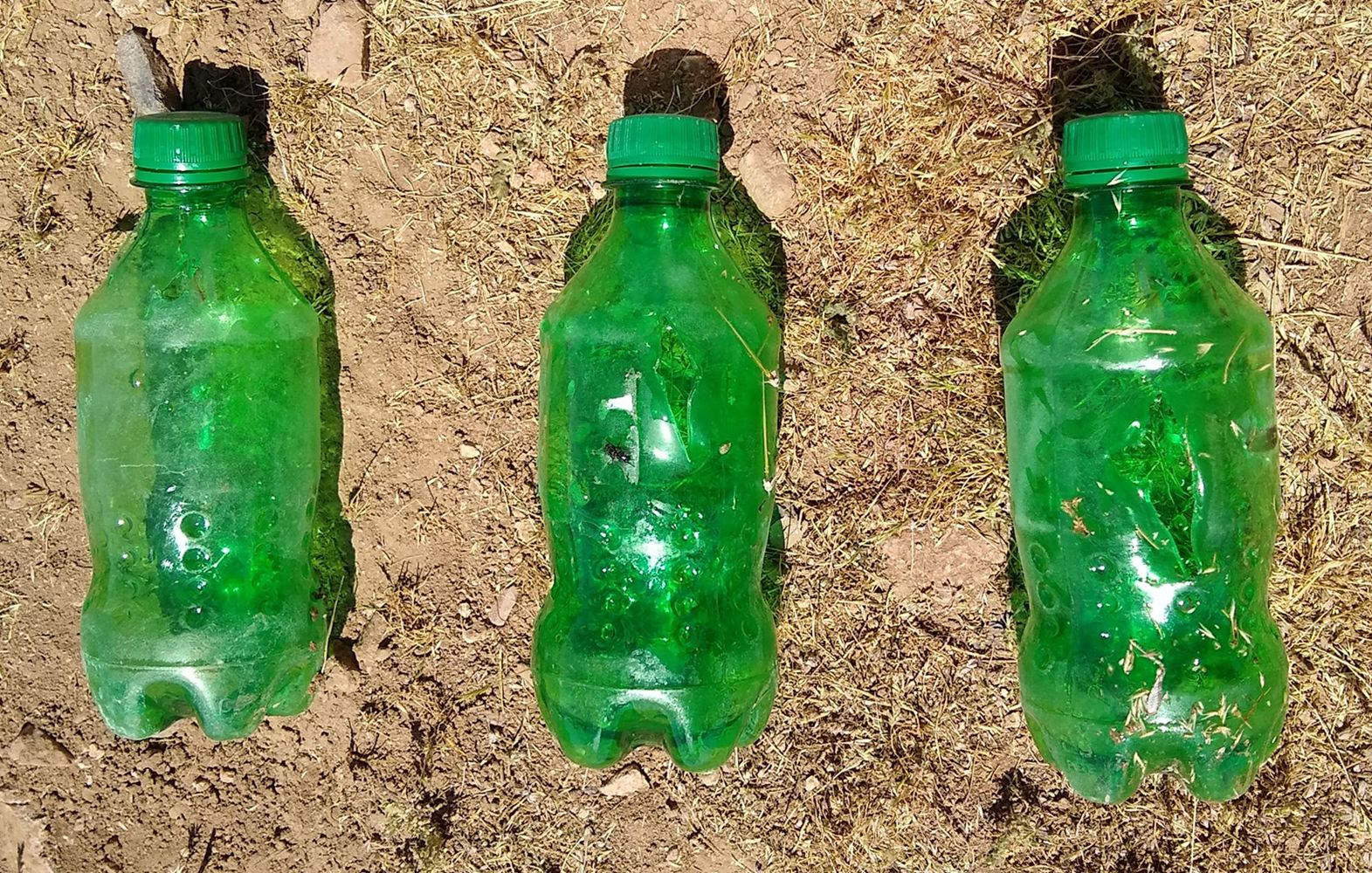 |
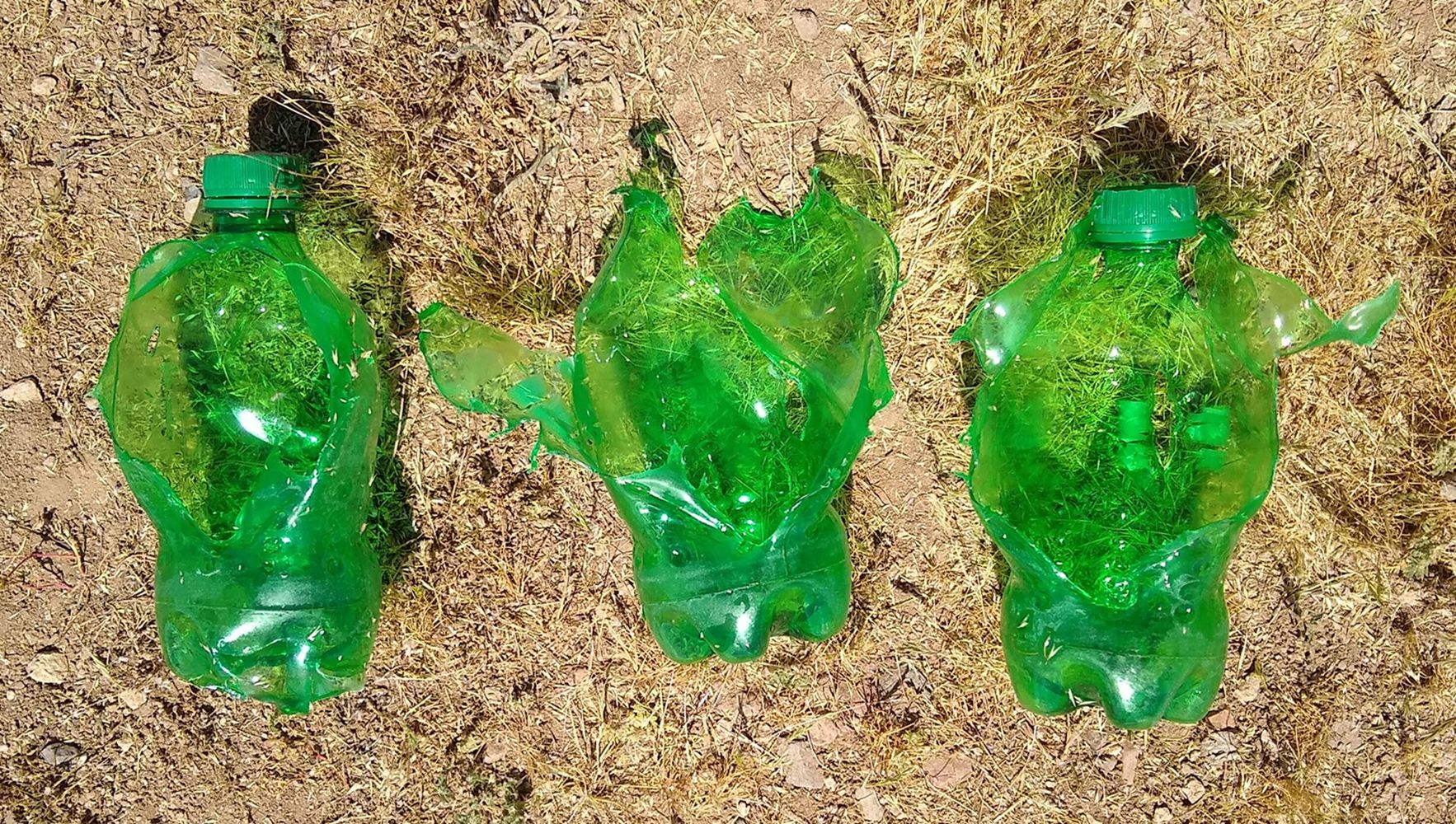 |
|
Bottles hit with Russian HP ammo |
Bottles hit with Hornady SST ammo |
|
The difference in expansion is obvious. |
At the end of my 50 yard testing, I took the target out to 128 yards, the longest
distance possible in the terrain I was shooting in. With the scope at 9-power, I got
a final sight-in with the Howa shooting the steel case Hornady SST ammo. The result
was under one inch, printing exactly where it should for that 165 yard zero. I think
that this should help dispel the notion that the 7.62x39 is an inherently inaccurate
round.
With friendly recoil, low cost ammo, and good accuracy, the Howa Mini Action 7.62x39
is a winner in my book.





